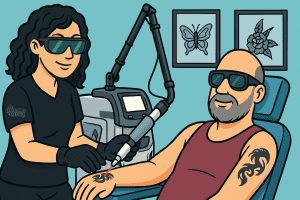Understanding Hyperpigmentation & Hypopigmentation After Laser Treatments
What It Is, Why It Happens, and How You Can Prevent It
Laser treatments—whether for tattoo removal, pigmentation correction, or skin rejuvenation—are incredibly effective, but they do come with some risks. One of the most common concerns is pigment changes in the skin: hyperpigmentation (darkening of the skin) and hypopigmentation (lightening of the skin).
As laser technicians, we always aim to minimize these risks, and in this post, we’ll explain what causes these changes and how you, as a client, can protect your skin before and after your sessions.
⸻
What is Hyperpigmentation?
Hyperpigmentation is when the skin becomes darker than your natural tone after a laser treatment. This is often caused by:
• Inflammation from the laser triggering excess melanin production
• Sun exposure post-treatment
• Picking or scratching healing skin
This is more common in clients with medium to dark skin tones (Fitzpatrick skin types III–VI) or those with a history of pigmentation issues.
⸻
What is Hypopigmentation?
Hypopigmentation is when the skin becomes lighter than your natural tone. This happens when:
• The laser damages melanocytes, the cells that produce melanin
• The skin doesn’t heal evenly
This can occur in all skin types but is more noticeable in darker complexions.
⸻
How We Help Prevent Pigment Changes
As your laser tech, here’s what we do to minimize risk:
1. Skin Type Assessment
We assess your Fitzpatrick skin type and history to customize your treatment. For darker skin types, we use safer wavelengths (like 1064 nm Nd:YAG) and adjust settings to reduce trauma.
2. Pre-Treatment Prep
For those prone to hyperpigmentation, we may recommend:
• Starting a topical lightening agent (kojic acid) 1–2 weeks before treatment
• Daily sunscreen use, even before your first session
3. Safe Laser Settings
We always use the lowest effective energy, appropriate spot sizes, and longer intervals between sessions to avoid overloading your skin.
4. Cooling and Protection
We use skin-cooling systems before, during, and after the laser to soothe the skin and reduce inflammation.
⸻
What You Can Do: Client Care Tips
Before Treatment
• Use SPF 50+ daily to protect your skin
• Avoid sun exposure and tanning beds for 2–4 weeks prior
• Let us know if you’re using any photosensitizing medications
After Treatment
• Apply SPF daily, even if it’s cloudy
• Avoid heat, sun, and sweating for 48–72 hours (unless you use an ice pack during a workout)
• Don’t pick or scratch healing skin
• Use soothing products like aloe Vera,Vitamin E, Vitamin D, Vitamin B3, or gentle moisturizers
• Consider post-care brightening products (with professional guidance)
⸻
If Pigmentation Changes Do Occur
Pigment changes are often temporary and improve over time—but early treatment helps. Let us know if you notice:
• Persistent dark patches: we may recommend lightening creams or a dermatologist referral.
• Light spots: we’ll pause treatments and monitor—repigmentation often returns slowly on its own.
⸻
Final Thoughts
Pigment changes are a manageable side effect of laser treatments—and with the right approach and aftercare, they can often be prevented or reversed. Our goal is to keep your skin safe while helping you achieve your aesthetic goals.
Have more questions about hyper- or hypopigmentation? We’re here to guide you every step of the way.

